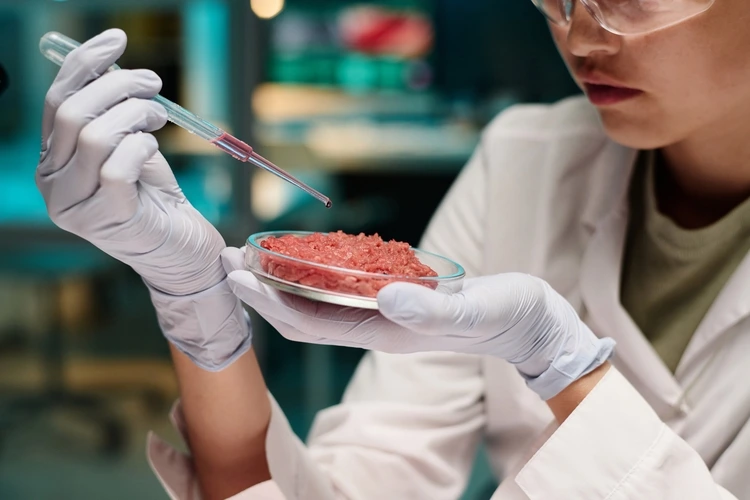
Discover more about lab-grown meat, how it is made and whether it can replace traditional meat
By
If you’re tucking into a chicken curry or a beef steak, it’s safe to assume that the former has come from a chicken, the latter from a cow. But what if there was a way to produce such animal products without the traditional raising and slaughter of living animals?
Enjoying this article? Check out our related reads:
This type of innovation, although it sounds straight from a sci-fi movie, is known as cultivated or lab-grown meat – genuine animal meat produced by cultivating animal cells in a safe and controlled environment. The process of creating such meat has been in development for approximately 20 years, with numerous companies contributing to research within the sector.
As of 2024, the industry has boomed to include more than 175 companies on six continents, backed by approximately $3.1 billion in investments. A major appealing factor for lab-grown meat is the significantly lower environmental footprint it has compared to traditional meat cultivation – compared with conventional beef, lab-grown beef requires 45 per cent less energy, 99 per cent land and produces 96 per cent fewer greenhouse gas emissions.
So, with current, traditional meat production embroiled in concerns due to its impact on the climate – from leading to deforestation for land use for cows, to the methane emissions released by cattle through burping and farting – cultivated meat could be a climate-friendly alternative. But is it possible to transition from traditional meat to this new kind? Or could high price points and limited research stunt the sector’s growth and public uptake?
How does it work?
To cultivate lab-grown meat, the process first involves gathering cells from an animal. These are commonly taken from animal embryos, bone marrow or muscle tissue. Suitable cells are then transferred into a bioreactor, a stainless steel vessel with the correct conditions to grow tissues. Such conditions include being given an oxygen-rich medium containing nutrients like amino acids, glucose, vitamins and salts.
Changes in this medium can trigger cells to change (known as differentiation) into the skeletal muscle, fat and connective tissues that make up meat. After spending time in a bioreactor undergoing differentation, cells are then fully grown. They can then be used in either unstructured meat products or to develop 3D structured tissues.

Unstructured meat products include chicken nuggets and hamburgers, whereas 3D structured tissues include steak and pork chops. 3D tissue structuring – also known as tissue engineering – embeds cells within a scaffold to simulate the texture of connective tissues.
Overall, the entire process can take anywhere between two and eight weeks, depending on the type of meat being cultivated. Despite the different way in which it is produced compared to traditional meat, lab-grown meat is real meat, containing the exact same cells as traditional meat.
What are the benefits?
Typically, meat has a high cholesterol and saturated fat content. But when growing meat in laboratories, scientists can control the quantities of these, helping to make meat a healthier alternative.
In addition, lab-grown meat can also help solve the ongoing issue of antibiotic resistance. That’s because animals would no longer need to be kept in factories, or bred in close proximity – all factors leading to antibiotic resistance. As well as this, lab-grown meat is resilient to bacteria, including E.Coli, helping to reduce instances of food poisoning.
Another huge benefit to lab-grown meat is for the environment. As of 2012, according to the UN, 26 per cent of the planet’s ice-free land was used for livestock farming, and a further 33 per cent of croplands were used for livestock feed production. Some of this strain could dissipate if alternative, lab-grown meats were consumed instead.
Will cultivated meat become popular?
Back in 2013, the first-ever lab-grown beef burger was produced at Maastricht University – taking two years to make – with a hefty price tag of $325,000. However, since then, companies have reduced production costs by 99 per cent.
In 2020, Singapore became the first and only country to approve the consumption of cultivated meat, with diners able to try out the first taste of lab-grown meat in a crispy sesame chicken dish developed by start-up Just Eat. According to the CEO of Just Eat, more than 70 per cent of people who’ve tried the company’s chicken say it tastes as good, or even better, than traditional chicken.
Fast forward to 2024, and additional cultivated meat products are under regulatory review in ten countries and regions, including the US, the EU, Singapore, New Zealand and the UK. Other countries are at various stages of regulation processes to allow the sale of cultivated meat.
Despite this success, lab-grown meat is still far from being popularised for many reasons.
For the cultivated meat industry to reach a $25 billion market size by 2030 – representing just a one per cent share in the global protein market – it would need to produce 1.5 million metric tons of lab-grown meat per year. This means the industry will need up to 440 million litres of fermentation capacity in bioreactors – enough to fill more than 170 Olympic-sized swimming pools. At the moment, the current capacity is just ten swimming pools.
In addition, only a few bioreactors around the world produce cultivated meat, so more would be needed to produce meat at scale.
As well as this, hefty work would need to be done to shift public perception of lab-grown meat. Long-term health effects of consuming this type of meat would also need to be explored.
Price may be a factor of least concern, however. If costs follow the same downward trajectory as they’ve done in the 20 years since lab-grown meat has been around, lab-grown meat may achieve cost parity with conventional meat by 2030.




